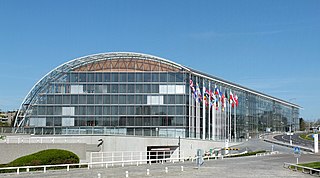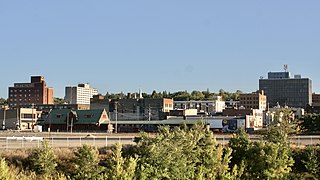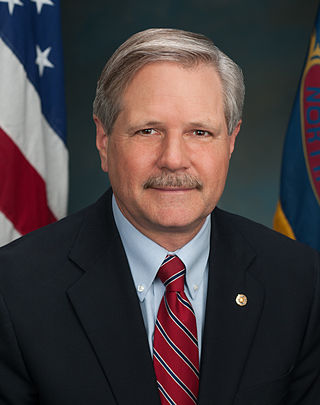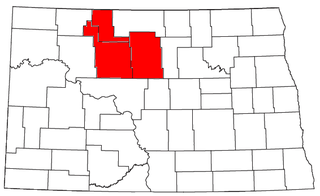Related Research Articles

The European Investment Bank (EIB) is the European Union's development bank and is owned by the EU Member States. It is one of the largest supranational lenders in the world. The EIB finances and invests both through equity and debt solutions projects that achieve the policy aims of the European Union through loans, guarantees and technical assistance.

Minot is a city in and the county seat of Ward County, North Dakota, United States, in the state's north-central region. It is most widely known for the Air Force base approximately 15 miles (24 km) north of the city. With a population of 48,377 at the 2020 census, Minot is the state's fourth-most populous city and a trading center for a large part of northern North Dakota, southwestern Manitoba, and southeastern Saskatchewan. Founded in 1886 during the construction of James J. Hill's Great Northern Railway, Minot is also known as "Magic City", commemorating its remarkable growth in size over a short time.

John Henry Hoeven III is an American banker and politician serving as the senior U.S. senator from North Dakota, a seat he has held since 2011. A member of the Republican Party, Hoeven served as the 31st governor of North Dakota from 2000 to 2010.

The Baltimore Convention Center is a convention and exhibition hall located in downtown Baltimore, Maryland. The center is a municipal building owned and operated by the City of Baltimore.
The Trans-European Networks (TEN) were created by the European Union by Articles 154–156 of the Treaty of Rome (1957), with the stated goals of the creation of an internal market and the reinforcement of economic and social cohesion. To various supporters of this policy, it made little sense to talk of a big EU market, with freedom of movement within it for goods, persons and services, unless the various regions and national networks making up that market were properly linked by modern and efficient infrastructure. The construction of Trans-European Networks was also seen as an important element for economic growth and the creation of employment.

The European Structural and Investment Funds are financial tools governed by a common rulebook, set up to implement the regional policy of the European Union, as well as the structural policy pillars of the Common Agricultural Policy and the Common Fisheries Policy. They aim to reduce regional disparities in income, wealth and opportunities. Europe's poorer regions receive most of the support, but all European regions are eligible for funding under the policy's various funds and programmes. The current framework is set for a period of seven years, from 2021 to 2027.
The Northwest Area Water Supply (NAWS), is a project to divert water from Lake Sakakawea to the area around Minot, North Dakota, which is in the Souris River watershed. Minot is roughly 40 miles north of Lake Sakakawea.

Jawaharlal Nehru National Urban Renewal Mission (JNNURM) was a massive city-modernization scheme launched by the Government of India under the Ministry of Urban Development. It envisaged a total investment of over $20 billion over seven years. It is named after Pt. Jawaharlal Nehru, the first Prime Minister of India. The aim is to encourage reforms and fast track planned development of identified cities. Focus is to be on efficiency in urban infrastructure and service delivery mechanisms, community participation, and accountability of ULBs/ Parastatal agencies towards citizens.

Gujarat International Finance Tec-City is a central business district under construction in Gandhinagar district in Gujarat, India. It is India's first operational greenfield smart city and international financial services centre, which the Government of Gujarat promoted as a greenfield project. In 2020 GIFT IFSC bagged 10th place in Finance Industry and top rank in emerging financial centres in Global Financial Centres Index. As of June 2023, it is home to 23 multi-national banks including HSBC, JP Morgan and Barclays; 35 fintech entities; two international stock exchanges with average daily trading volumes of $30.6 billion; as well as India’s first international bullion exchange with 75 onboarded jewellers.

The Minot Micropolitan Statistical Area, as defined by the United States Census Bureau, is an area consisting of three counties in North Dakota, anchored by the city of Minot. As of the 2010 census, the area had a population of 69,540. In 2012, it was estimated that the population of the Minot Micropolitan Area was 73,146.

The 2008–09 Chinese economic stimulus plan is a RMB¥ 4 trillion stimulus package announced by the State Council of the People's Republic of China on 9 November 2008 as an attempt to minimize the impact of the financial crisis of 2007–2008 on the economy of China. Critics of China's stimulus package have blamed it for causing a surge in Chinese debt since 2009, particularly among local governments and state-owned enterprises.
The official history of motion picture production in the U.S. state of Michigan dates back to the beginning of the Post–World War II baby boom. As of March 14, 2013, the Michigan Film Office website contains a list of 319, filmed in Michigan titles, beginning with This Time for Keeps, starring Esther Williams and in 1946, followed by Anatomy of a Murder, starring Jimmy Stewart and Lee Remick in 1959. Contemporary nationally known works filmed in the state include the drama Conviction (2010), starring Hilary Swank and Sam Rockwell, Kill the Irishman (2011), starring Val Kilmer and Christopher Walken, HBO's series Hung was filmed, and is set in, Detroit, and the Discovery Channel's Motor City Motors (2009), formerly Monster Garage (2002-2006). Originally slated for Minneapolis, Minnesota, Clint Eastwood's film Gran Torino (2008) was filmed in the Detroit area.
Metropolitan Area Projects Plan (MAPS) is a multi-year, municipal capital improvement program, consisting of a number of projects, originally conceived in the 1990s in Oklahoma City by its then mayor Ron Norick. A MAPS program features several interrelated and defined capital projects, funded by a temporary sales tax, administered by a separate dedicated city staff funded by the sales tax, and supervised by a volunteer citizens oversight committee.
SRT Communications is the largest telecommunications cooperative in North Dakota, serving over 99,000 people with Internet, Security Alarm and Video Surveillance, and Business Phone Systems and services.
The New York City Regional Center (NYCRC) secures capital for real estate and infrastructure projects throughout New York City. Established in 2008, NYCRC has provided over $1.5 billion of capital to help fund a broad spectrum of economic development projects in Brooklyn, Queens, Manhattan, and the Bronx. These projects have successfully utilized NYCRC financing to assist in the construction of over 3.5 million square feet of new development and renovation as well as infrastructure upgrades resulting in thousands of new jobs for New Yorkers.

Downtown Minot is the central business district of Minot, North Dakota, located south of the Souris River in the Souris Valley. Downtown is the site of the first permanent settlement in Minot in 1886. Downtown is home to many of Minot's cultural sites of interest. It is also home to numerous galleries, stores and restaurants. The Minot Riverwalk traverses the downtown.

North Hill is a neighborhood in Minot, North Dakota, located north of the Souris River, above the Souris River Valley. It is a primarily residential neighborhood, though there are industries and businesses in the area, primarily along North Broadway and 21st Ave NW. North Hill is also home to Minot International Airport.

South Hill is a neighborhood in Minot, North Dakota, located south of the Souris River, above the Souris River Valley. It is a primarily residential neighborhood, although there are commercial zones along South Broadway, Twentieth Avenue South and around the Dakota Square Mall.

Jawaharlal Nehru National Urban Renewal Mission was renamed to Atal Mission for Rejuvenation and Urban Transformation (AMRUT) and then relaunched by Prime Minister of India Narendra Modi in June 2015 with the focus to establish infrastructure that could ensure adequate robust sewage networks and water supply for urban transformation by implementing urban revival projects. Rajasthan was the first state in the country to submit State Annual Action Plan under Atal Mission for Rejuvenation and Urban Transformation (AMRUT). The scheme Housing for All by 2022 and Atal Mission for Rejuvenation and Urban Transformation (AMRUT) were launched on the same day. The scheme is dependent with public–private partnership(PPP) model. If required, various other schemes like Swachh Bharat Mission, Housing for All 2022, along with the local state schemes like that related to water supply and sewerage and other infrastructure related schemes can be linked to AMRUT.

Regional economy in Wales is centred on four regional economic boards in Wales. Each board oversees a city or growth deal, signed between 2016 and 2022, lasting 10–15 years. Two of the deals are city deals signed and proposed by their respective economic boards, and their areas are described as "city regions"; the Cardiff Capital Region and Swansea Bay City Region. Whereas in North Wales, the North Wales Economic Ambition Board negotiated a North Wales growth deal signed in 2020, and in Mid Wales, the Growing Mid Wales Partnership, led negotiations for a Mid Wales growth deal signed in 2022. The programmes are based on the City deal and Growth deal initiatives set up by the Coalition UK Government in 2012, to promote the decentralisation of the UK economy, by stimulating local economic growth.
References
- 1 2 3 Schramm, Jill. “Minot’s growth fund has worked like MAGIC” Archived 2011-06-15 at the Wayback Machine . Minot Daily News. Hometown Headlines 2008. Posted October 1, 2008. Retrieved on November 1, 2008.
- 1 2 3 4 Schramm, Jill. “Minot’s growth fund has worked like MAGIC”. Archived 2011-06-15 at the Wayback Machine Minot Daily News. Hometown Headlines 2008. Posted October 1, 2008. Retrieved on November 1, 2008.
- ↑ Schramm, Jill. “Public shares advice for MAGIC Fund” Archived 2011-06-15 at the Wayback Machine . Minot Daily News. Posted October 8, 2008. Retrieved on November 1, 2008.
- ↑ Schramm, Jill. "MAGIC Fund guidelines reviewed." Archived 2011-06-15 at the Wayback Machine Minot Daily News. Posted on November 26, 2008. Retrieved on December 30, 2013.
- ↑ Davis, Jenna. “MAGIC Fund members want to know if spending taxpayer dollars is ‘paying off.’” Minot Daily News. March 27, 2005. pg A1
- ↑ Schramm, Jill. “Public shares advice for MAGIC Fund”. Archived 2011-06-15 at the Wayback Machine Minot Daily News. Posted October 8, 2008. Retrieved on November 1, 2008.
- ↑ Ondracek, James. The rise and fall of WebSmart Interactive: A cautionary tale. Archived 2011-08-26 at the Wayback Machine Small Business Advancement National Center. Retrieved on December 12, 2008.
- ↑ Rafferty, Tom. “MedVision expected to reimburse fund soon.” Minot Daily News. April 13, 2002. pg 1A.
- ↑ Rafferty, Tom. “Value under analysis.” Minot Daily News. December 22, 2000. p A1.
- ↑ Witte, Brian. “Study shows positive results.” Minot Daily News. June 5, 2001. p A1.
- 1 2 City of Minot Finance Department. MAGIC Fund Annual Compliance Report 2006 [ permanent dead link ]
- ↑ Schramm, Jill. “MADC repays $857K to MAGIC Fund.” Minot Daily News. September 25, 2008. pg 1A.
- ↑ Chapter 28 ½, Article IV, Section 112 (2). Minot Code of Ordinances. City Council Action, April 2, 1990 (Committee Membership and Terms). City Council Action, June 2, 1997 (Terms)
- ↑ Schramm, Jill. “More training requested.” Minot Daily News. October 4, 2005. pg B1.